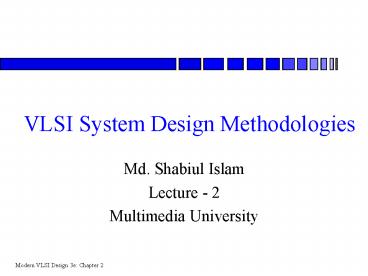VLSI System Design Methodologies - PowerPoint PPT Presentation
1 / 30
Title:
VLSI System Design Methodologies
Description:
Fabrication services. We need to study fabrication ... Fabrication processes. A cross section of an integrated circuit is shown in Figure in next page. ... – PowerPoint PPT presentation
Number of Views:215
Avg rating:3.0/5.0
Title: VLSI System Design Methodologies
1
VLSI System Design Methodologies
- Md. Shabiul Islam
- Lecture - 2
- Multimedia University
2
Topics
- Basic fabrication steps.
- Transistor structures.
- Basic transistor behavior.
- Latch up.
3
Fabrication services
- We need to study fabrication processes and the
design rules that govern layout. We will use as
our example the SCMOS rules, which have been
defined by MOSIS, the MOS Implementation service. - Similar services, such as Euro Chip/Euro Practice
in the European Community, VDEC in Japan, and CIC
in Taiwan, serve educational VLSI needs in other
Countries.
4
- Educational services
- U.S. MOSIS
- EC EuroPractice
- Taiwan CIC
- Japan VDEC
- Foundry fabrication line for hire.
- Foundries are major source of fab capacity today.
5
Fabrication processes
- A cross section of an integrated circuit is shown
in Figure in next page. Integrated circuits are
built on a silicon substrate. Components are
formed by a combination of processes - The n-type and p-type regions can be used to make
wires as well as transistors, but polysilicon (
which is also used to form -
6
- Transistor gates) and metal are the primary
materials for wiring together transistors because
of their superior electrical properties. - IC built on silicon substrate
- some structures diffused into substrate
- other structures built on top of substrate.
7
- Substrate regions are doped with n-type and
p-type impurities. (n heavily doped) - Wires made of polycrystalline silicon (poly),
multiple layers of aluminum (metal). - Silicon dioxide (SiO2) is insulator.
8
Simple cross section
SiO2
metal3
metal2
metal1
poly
substrate
n
n
p
substrate
9
Photolithography
- Features are patterned on the wafer by a
photolithographic process the wafer is covered
with light-sensitive material called
photoresist,which is then exposed to light with
the proper pattern.
10
Process steps
- Transistors are fabricated within regions
- called tubs or wells
- First place tubs to provide properly-doped
substrate for n-type, p-type transistors
11
Process steps, contd.
- Pattern polysilicon before diffusion regions
gate oxide
poly
poly
p-tub
p-tub
12
Process steps, contd
- Add diffusions, performing self-masking
poly
poly
p-tub
p-tub
n
n
p
p
13
Process steps, contd
- Start adding metal layers
metal 1
metal 1
vias
poly
poly
p-tub
p-tub
n
n
p
p
14
- Figure in next page shows the cross-section of
n-type MOS transistor. An n-type transistor is
embedded in a p-type substrate it is formed by
the intersection of an n-type wire and a
polysilicon wire. - The region at the intersection , called the
channel, is where the transistor action takes
place.
15
Transistor structure
- n-type transistor
16
0.25 micron transistor (Bell Labs)
gate oxide
silicide
source/drain
poly
17
Transistor layout
- Example The basic layout of an n-type (tubs may
vary) transistor is simple This layout is a
minimum-size transistor. Current flow through the
channel vertically.
18
Drain current characteristics
19
- Vgs the gate to source voltage
- Vds the drain to source voltage
- Idthe current flowing between the drain and
source. - Vt the transistor threshold voltage, which is
positive for an n-type transistor and negative
for a p-type transistor - W/L the width to length ratio of the transistor.
20
Drain current
- For an n-type transistor, we have,
- Linear region (Vds lt Vgs - Vt)
- Id k (W/L)(Vgs - Vt)(Vds - 0.5 Vds2)
- Saturation region (Vds gt Vgs - Vt)
- Id 0.5k (W/L)(Vgs - Vt) 2
21
0.5 ?m transconductances
- From a MOSIS process
- n-type
- kn 73 ?A/V2
- Vtn 0.7 V
- p-type
- kp 21 ?A/V2
- Vtp -0.8 V
22
Current through a transistor
- Use 0.5 ?m parameters. Let W/L 3/2. Measure at
boundary between linear and saturation regions. - Vgs 2V
- Id 0.5k(W/L)(Vgs-Vt)2 93 ?A
- Vgs 5V
- Id 1 mA
23
Basic transistor parasitics
- Real devices have parasitic elements which are
necessary artifacts of the device structure.
Since the transistor is a non-linear device, we
are primarily concerned with its capacitance as
parasitics, although the source and drain regions
have significant resistance.
24
Basic transistor parasitics
- Gate to substrate, also gate to source/drain.
- Source/drain capacitance, resistance.
25
Basic transistor parasitics, contd
- Gate capacitance Cg. Determined by active area.
- Source/drain overlap capacitances Cgs, Cgd.
Determined by source/gate and drain/gate
overlaps. Independent of transistor L. - Cgs Col W
- Gate/bulk overlap capacitance.
26
Latch-up
- CMOS ICs have parastic silicon-controlled
rectifiers (SCRs). - When powered up, SCRs can turn on, creating
low-resistance path from power to ground. Current
can destroy chip. - Early CMOS problem. Can be solved with proper
circuit/layout structures.
27
Parasitic SCR
circuit
I-V behavior
28
Parasitic SCR structure
29
Solution to latch-up
- Use tub ties to connect tub to power rail. Use
enough to create low-voltage connection.
30
Tub tie layout
p
metal (VDD)
p-tub































